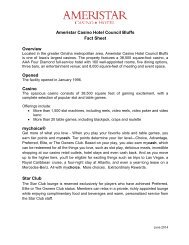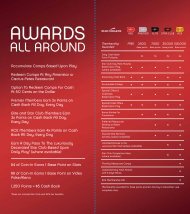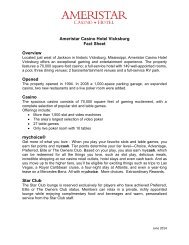<strong>Inc</strong>ome TaxesOur income tax returns are subject to examination by the Internal Revenue Service (“IRS”) and other taxauthorities in the locations where we operate. We assess potentially unfavorable outcomes of such examinationsbased on the criteria of FIN 48, which we adopted on January 1, <strong>2007</strong>. FIN 48 prescribes a minimum recognitionthreshold a tax position is required to meet before being recognized in the financial statements. As a result, ourincome tax recognition policy related to uncertain income tax positions is no longer covered by SFAS No. 5. FIN 48applies to all tax positions related to income taxes subject to SFAS No. 109. FIN 48 utilizes a two-step approach forevaluating tax positions. Recognition (Step I) occurs when we conclude that a tax position, based on its technicalmerits, is more likely than not to be sustained upon examination. Measurement (Step II) is only addressed if theposition is deemed to be more likely than not to be sustained. Under Step II, the tax benefit is measured as thelargest amount of benefit that is more likely than not to be realized upon settlement. FIN 48’s use of the term “morelikely than not” is consistent with how that term is used in SFAS No. 109 (i.e., the likelihood of occurrence isgreater than 50%).The tax positions failing to qualify for initial recognition are to be recognized in the first subsequent interimperiod that they meet the “more likely than not” standard. If it is subsequently determined that a previouslyrecognized tax position no longer meets the “more likely than not” standard, it is required that the tax position bederecognized. FIN 48 specifically prohibits the use of a valuation allowance as a substitute for derecognition of taxpositions. As applicable, we will recognize accrued penalties and interest related to unrecognized tax benefits in theprovision for income taxes.Recently Issued Accounting StandardsSFAS No. 157In September 2006, the FASB issued SFAS No. 157, “Fair Value Measurements,” which defines fair value,establishes a framework for measuring fair value in generally accepted accounting principles and expandsdisclosures about fair value measurements. SFAS No. 157 clarifies how to measure fair value as permitted underother accounting pronouncements, but does not require any new fair value measurements. We adopted SFAS No.157 as of January 1, 2008. The adoption of SFAS No. 157 is not expected to have a material impact on our financialposition, results of operations or cash flows.SFAS No. 159In February <strong>2007</strong>, the FASB issued SFAS No. 159, “The Fair Value Option for Financial Assets and FinancialLiabilities <strong>Inc</strong>luding an Amendment of FASB Statement No. 115.” SFAS No. 159 permits entities to choose tomeasure many financial instruments and certain other items at fair value, with unrealized gains and losses related tothese financial instruments reported in earnings at each subsequent reporting date. SFAS No. 159 is effective forfiscal years beginning after November 15, <strong>2007</strong>. The adoption of SFAS No. 159 is not expected to have a materialimpact on our financial position, results of operations or cash flows.SFAS No. 141(R)In December <strong>2007</strong>, the FASB issued SFAS No. 141 (Revised <strong>2007</strong>), “Business Combinations” (“SFAS No.141(R)”). SFAS No. 141(R) will significantly change the accounting for business combinations. Under SFAS No.141(R), an acquiring entity will be required to recognize all the assets acquired and liabilities assumed in atransaction at the acquisition-date fair value with limited exceptions. SFAS No. 141(R) will change the accountingtreatment for certain specific acquisition-related items, including: (1) expensing acquisition-related costs as incurred;(2) valuing noncontrolling interests at fair value at the acquisition date; and (3) expensing restructuring costsassociated with an acquired business. SFAS No. 141(R) also includes a substantial number of new disclosurerequirements. SFAS No. 141(R) is to be applied prospectively to business combinations for which the acquisitiondate is on or after January 1, 2009. We expect SFAS No. 141(R) will have an impact on our accounting for futurebusiness combinations once adopted but the effect is dependent upon the acquisitions, if any, that are made in thefuture.52
Item 7A. Quantitative and Qualitative Disclosures About Market RiskMarket risk is the risk of loss arising from adverse changes in market rates and prices, such as interest rates,foreign currency exchange rates and commodity prices. Our primary exposure to market risk is interest rate riskassociated with our senior credit facilities. As of December 31, <strong>2007</strong>, we had $1.6 billion outstanding under oursenior credit facilities, bearing interest at variable rates. The senior credit facilities bear interest equal to LIBOR (inthe case of Eurodollar loans) or the prime interest rate (in the case of base rate loans), plus an applicable margin, or“add-on.” At December 31, <strong>2007</strong>, the average interest rate applicable to the senior credit facilities was 7.2%. Anincrease of one percentage point in the average interest rate applicable to the senior credit facilities outstanding atDecember 31, <strong>2007</strong> would increase our annual interest cost by approximately $16.4 million.Substantially all of our long-term debt is subject to variable interest rates. We continue to monitor interest ratemarkets and, in order to control interest rate risk, may enter into interest rate collar or swap agreements or otherderivative instruments as market conditions warrant. We may also choose to refinance a portion of our variable ratedebt through the issuance of long-term fixed-rate debt.Item 8. Financial Statements and Supplementary DataThe <strong>Report</strong>s of Independent Registered Public Accounting Firm appear at pages F-2 and F-3 hereof, and ourConsolidated Financial Statements and Notes to Consolidated Financial Statements appear at pages F-4 throughF-22 hereof.Item 9. Changes in and Disagreements with Accountants on Accounting and Financial DisclosureNone.Item 9A. Controls and Procedures(a) Evaluation of Disclosure Controls and ProceduresWe maintain disclosure controls and procedures, as defined in Rules 13a-15(e) and 15d-15(e) promulgated underthe Securities Exchange Act of 1934 (the “Exchange Act”), that are designed to ensure that information required tobe disclosed by us in the reports that we file or submit under the Exchange Act is recorded, processed, summarizedand reported within the time periods specified in the Securities and Exchange Commission’s rules and forms andthat such information is accumulated and communicated to our management, including our Chief Executive Officerand President and our Chief Financial Officer, as appropriate, to allow timely decisions regarding requireddisclosure. We carried out an evaluation, under the supervision and with the participation of our management,including our Chief Executive Officer and President and our Chief Financial Officer, of the effectiveness of thedesign and operation of our disclosure controls and procedures as of December 31, <strong>2007</strong>. Based on the evaluation ofthese disclosure controls and procedures, the Chief Executive Officer and President and Chief Financial Officerconcluded that our disclosure controls and procedures were effective.(b) Management’s <strong>Annual</strong> <strong>Report</strong> on Internal Control over Financial <strong>Report</strong>ing and <strong>Report</strong> of IndependentRegistered Public Accounting FirmThe information required to be furnished pursuant to this item is set forth under the captions “Management’s<strong>Annual</strong> <strong>Report</strong> on Internal Control over Financial <strong>Report</strong>ing” and “<strong>Report</strong> of Independent Registered PublicAccounting Firm” and is included in this <strong>Annual</strong> <strong>Report</strong> at pages F-1 and F-2.(c) Changes in Internal Control over Financial <strong>Report</strong>ingAs required by Rule 13a-15(d) under the Exchange Act, our management, including our Chief Executive Officerand President and our Chief Financial Officer, has evaluated our internal control over financial reporting todetermine whether any changes occurred during the fourth fiscal quarter of <strong>2007</strong> that materially affected, or arereasonably likely to materially affect, our internal control over financial reporting. Based on that evaluation, therewas no such change during the fourth fiscal quarter of <strong>2007</strong>.Item 9B. Other InformationNot applicable.53
- Page 3 and 4:
Dear Fellow Shareholders,I am pleas
- Page 5 and 6:
Ameristar Black Hawk, which reporte
- Page 7 and 8: UNITED STATES SECURITIES AND EXCHAN
- Page 9 and 10: Unless the context indicates otherw
- Page 11 and 12: Ameristar St. Charles. Ameristar St
- Page 13 and 14: Ameristar Vicksburg. Ameristar Vick
- Page 16 and 17: Kansas CityAmeristar Kansas City co
- Page 18 and 19: Should additional gaming developmen
- Page 20 and 21: The Missouri Act provides for a buy
- Page 22 and 23: Iowa has a graduated wagering tax e
- Page 24 and 25: The Indiana Act provides that the s
- Page 26 and 27: after receiving notice that a perso
- Page 29 and 30: Pursuant to an amendment to the Col
- Page 31 and 32: There are various classes of retail
- Page 33 and 34: The Nevada Commission may, at its d
- Page 35 and 36: Item 1A. Risk FactorsThe gaming ind
- Page 37 and 38: two years, our gaming licenses in I
- Page 39 and 40: We have limited opportunities to de
- Page 41 and 42: The Ameristar Vicksburg site has ex
- Page 43 and 44: PART IIItem 5. Market for Registran
- Page 45 and 46: AMERISTAR CASINOS, INC.CONSOLIDATED
- Page 47 and 48: the rebranding, improving from an 1
- Page 49 and 50: The following table presents detail
- Page 51 and 52: Operating IncomeIn 2006, consolidat
- Page 53 and 54: At Ameristar St. Charles, we are ne
- Page 55 and 56: Historically, we have funded our da
- Page 57: Customer Rewards ProgramsOur custom
- Page 61 and 62: (a) 2. Financial Statement Schedule
- Page 63 and 64: ExhibitNumber Description of Exhibi
- Page 65 and 66: SIGNATURESPursuant to the requireme
- Page 67 and 68: MANAGEMENT’S ANNUAL REPORT ON INT
- Page 69 and 70: REPORT OF INDEPENDENT REGISTERED PU
- Page 71 and 72: AMERISTAR CASINOS, INC.CONSOLIDATED
- Page 73 and 74: AMERISTAR CASINOS, INC.CONSOLIDATED
- Page 75 and 76: InventoriesInventories primarily co
- Page 77 and 78: Income taxesIncome taxes are record
- Page 79 and 80: The Company recorded $5.6 million,
- Page 81 and 82: Senior credit facilitiesIn November
- Page 83 and 84: Future minimum lease payments requi
- Page 85 and 86: Years ended December 31,2007 2006 2
- Page 87 and 88: The unaudited pro forma consolidate
- Page 89 and 90: STOCK PRICE PERFORMANCEThe followin









